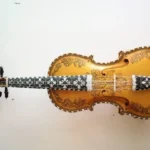
The sitar, a beloved and iconic instrument of India, has a rich history that spans centuries. As we embark on this musical journey, we’ll uncover 25 intriguing facts, anecdotes, and cultural insights about the sitar. Originating in the heart of India, this mystical instrument has not only captivated audiences within its homeland but has also made a profound impact on the global music stage. From its invention by the ingenious Amir Khusrow to its collaboration with iconic musicians like Ravi Shankar and George Harrison, the sitar’s enchanting melodies have transcended boundaries. Join us as we delve into the world of the sitar, exploring its construction, cultural significance, and its pivotal role in shaping the sound of Indian classical music and beyond.
Origins: The sitar’s origins trace back to the 13th century in India. It was initially derived from the Persian “sehtar,” and over time, it evolved into the beautiful, stringed instrument we know today. Its history is deeply intertwined with the development of Indian classical music and cultural heritage.
Invention: Amir Khusrow, a renowned Sufi musician, poet, and scholar, is credited with inventing the sitar. He sought to create an instrument that could better capture the intricacies of Indian ragas and melodies. His innovative spirit led to the birth of the sitar, which went on to become a pivotal instrument in Indian classical music.
Construction: The sitar’s construction is a testament to craftsmanship and tradition. Craftsmen typically use seasoned teak wood for the main body, resonator gourds for sound production, and bone for the bridge and frets. This meticulous approach to construction ensures the instrument’s unique tonal qualities.
Materials: The use of natural materials such as wood and gourds not only lends the sitar its distinctive sound but also connects it to the earth and nature. The blend of these organic materials has been an integral part of sitar-making traditions for centuries.
Bridge: The “jawari” or the bridge is a central component that gives the sitar its signature sound. The curvature and design of the jawari create the buzzing effect when the strings are plucked. This adds a resonant quality to the music that is unique to the sitar.
Fret Count: The presence of 20 movable frets on the sitar’s neck is a significant aspect of its design. Musicians can adjust the frets to produce microtonal variations, a hallmark of Indian classical music, allowing them to perform the intricate melodies and ornamentations central to the genre.
Notation System: Indian classical music employs a complex system of notation, including ragas (melodic modes) and talas (rhythmic patterns). Learning and mastering this notation is an essential part of becoming a proficient sitar player.
Player Position: Sitar players sit cross-legged while performing, demonstrating the deep connection between the instrument and the culture. This seated posture allows for precise control of finger movements and expression while playing.
Famous Sitarists: Ravi Shankar’s name is synonymous with the sitar. His virtuosity and pioneering efforts introduced the instrument to audiences worldwide, transcending cultural boundaries. His collaborations with George Harrison and contributions to fusion music helped bridge the gap between East and West.
Strings Tuning: The standard tuning of a sitar, Sa, Re, Ga, Ma, Pa, Dha, Ni, Sa, is fundamental to the instrument’s music. It provides a base upon which sitarists can build intricate melodies and explore the depths of Indian classical music. This tuning reflects the tonal structure of ragas and serves as the foundation for improvisation and performance.
Cultural Significance: The sitar is deeply rooted in Indian culture and spirituality. It often features in classical music performances during religious and festive occasions. Its resonant tones are believed to evoke a sense of divine connection and transcendence.
Rise in Popularity: The 1960s marked a significant turning point for the sitar’s popularity. This was largely due to Ravi Shankar’s collaboration with George Harrison, which introduced Western audiences to the instrument. The sitar’s exotic sound played a pivotal role in shaping the era’s music and counterculture.
Concerto for Sitar: Ravi Shankar’s sitar concerto, performed with the London Symphony Orchestra in 1971, showcased the instrument’s versatility and adaptability. This collaboration melded classical and orchestral music traditions, pushing the boundaries of sitar’s capabilities.
String Variations: Different styles of sitar have varying string configurations. The “Kharaj Pancham” style is the most common, featuring five strings for melody and a drone. The “Gandhaar Pancham” style is known for two strings tuned to the same note, creating distinct harmonic possibilities.
Gandhaar Pancham Style: This unique sitar style, where two strings are tuned to the same note, opens up the potential for rich and layered soundscapes in Indian classical music. It allows musicians to create complex melodic patterns and explore the depths of raga improvisation.
Weight: Sitars typically weigh between 5 to 8 kilograms. This weight makes them relatively easy to handle and transport for performances, despite their intricate construction.
Length: The standard sitar is approximately 1.2 meters (4 feet) long. This size strikes a balance between playability and the ability to produce the instrument’s signature sound.
Innovation: Ravi Shankar’s innovative contributions to the sitar’s design included the addition of a second resonator gourd. This innovation expanded the instrument’s tonal range and improved its resonance, making it more adaptable to Western orchestration.
Sitar Maestro: Vilayat Khan, a celebrated sitar virtuoso, made remarkable contributions to Indian classical music. His technical brilliance and innovative compositions continue to influence aspiring sitarists and music enthusiasts.
Fusion Music: The sitar’s adaptability has led to its incorporation into various fusion music genres, including collaborations with jazz, rock, and world music. Musicians from different cultures have embraced the sitar as a bridge between musical traditions, creating exciting and experimental compositions.
Historical Range Reduction: While the sitar itself doesn’t have a “historical range” like a living organism, its cultural and geographical range has expanded significantly over time. Originally rooted in North India, it has since spread across the world, becoming a symbol of Indian classical music.
Captive Breeding Programs: In contrast to animals, sitars do not have captive breeding programs. However, there are efforts to preserve the craft of sitar-making and to pass down the traditional techniques from one generation to the next.
Recorded Longevity: Sitars, with proper care, can last for generations. Their longevity is a testament to the quality of craftsmanship and the resilience of natural materials like wood. Well-maintained sitars often remain in playing condition for decades.
Trade Threats: As a musical instrument, the sitar faces no threats from illegal trade. However, there are concerns about the use of endangered woods in sitar construction, leading to calls for responsible sourcing and the use of alternative materials.
Cultural Myths: The sitar, as a cultural icon, is steeped in myth and legend. Its melodies are said to have the power to evoke emotions, heal the spirit, and transcend the ordinary world. These myths and stories contribute to its enduring significance in Indian culture and classical music.
Sitar FAQs: Unveiling the Melodies of India
The sitar, with its long neck and mesmerizing sound, is a stringed instrument central to Hindustani classical music, the North Indian classical tradition. Here’s a breakdown of some of the most frequently asked questions about this captivating instrument:
1. What is a sitar, and what are its parts?
- Instrument: The sitar is a fretted string instrument belonging to the lute family, similar to the Western guitar.
- Parts:
- Body (Tumba): A large, hollow gourd resonating chamber that amplifies the sound. Traditionally made from a gourd, some sitars use wood or other composites for durability.
- Neck (Dandi): A long, fretted wooden neck where the player presses the strings to change pitch.
- Strings: There are typically around 20 strings on a sitar, categorized into:
- Main playing strings (4-5): These are plucked to create the melody.
- Drone strings (1-2): Continuously sound a single pitch, providing a harmonic base.
- Sympathetic strings (12-13): Vibrate in resonance with the other strings, adding richness and complexity to the sound.
- Bridges: Two bridges – a large main bridge for the main and drone strings, and a smaller bridge near the neck for the sympathetic strings.
- Tuning pegs: There are two sets of tuning pegs – lateral pegs for the main strings and drone strings, and machine head pegs for the sympathetic strings.
- Jawari: A metal plate near the main bridge used for rhythmic strumming and ornamentation.
2. What kind of music is played on the sitar?
The sitar is primarily used in Hindustani classical music, which emphasizes improvisation and melodic exploration within a specific melodic framework called a raga. However, the sitar’s versatility has led to its inclusion in other genres like Indian fusion, folk music, and even some film soundtracks.
3. How is the sitar played?
Playing the sitar requires a combination of fingerpicking techniques on the melody strings, fretting with the left hand, and manipulating the drone strings with the right hand for rhythmic emphasis. The player sits on the floor and plucks the strings with a wire plectrum worn on the index finger. The sitar is known for its characteristic bends and slides (glissandos) called meends, which add an expressive quality to the music.
4. Who are some famous sitar players?
- Ravi Shankar: A legendary sitarist who popularized the instrument globally through collaborations with Western musicians like The Beatles.
- Vilayat Khan: Known for his innovative playing style and focus on rhythmic improvisation.
- Nikhil Banerjee: Renowned for his expressiveness and mastery of melody.
- Anoushka Shankar: Daughter of Ravi Shankar, who carries on the tradition with her own contemporary approach.
5. Where can I learn to play the sitar?
Learning sitar requires dedication and guidance from a qualified teacher. Here are some options:
- Find a sitar teacher: Look for experienced sitar players who offer lessons in your area.
- Online lessons: There are online resources and platforms offering sitar lessons through video conferencing.
- Music schools: Some music schools or institutes specializing in Indian classical music might offer sitar courses.
6. How much does a sitar cost?
The cost of a sitar can vary depending on the quality, materials, and craftsmanship. Student model sitars can start around $500, while professional-grade instruments made by renowned makers can cost upwards of $10,000.
7. How to care for a sitar?
- Temperature and humidity control: The sitar is sensitive to temperature and humidity changes, which can affect the sound and stability. Ideally, store it in a cool, dry place with a consistent temperature.
- String care: Regularly replace broken strings and wipe down the remaining strings to prevent corrosion.
- Cleaning: Use a soft, dry cloth to wipe down the body and neck. Avoid using harsh chemicals or solvents.
- Case: Always keep the sitar in a sturdy case when not in use for protection.
Hopefully, this FAQ equips you with a deeper understanding of the sitar, its captivating sound, and its place in Indian music. Whether you’re a curious listener or an aspiring sitarist, this instrument offers a rich journey into the world of melody and improvisation.








